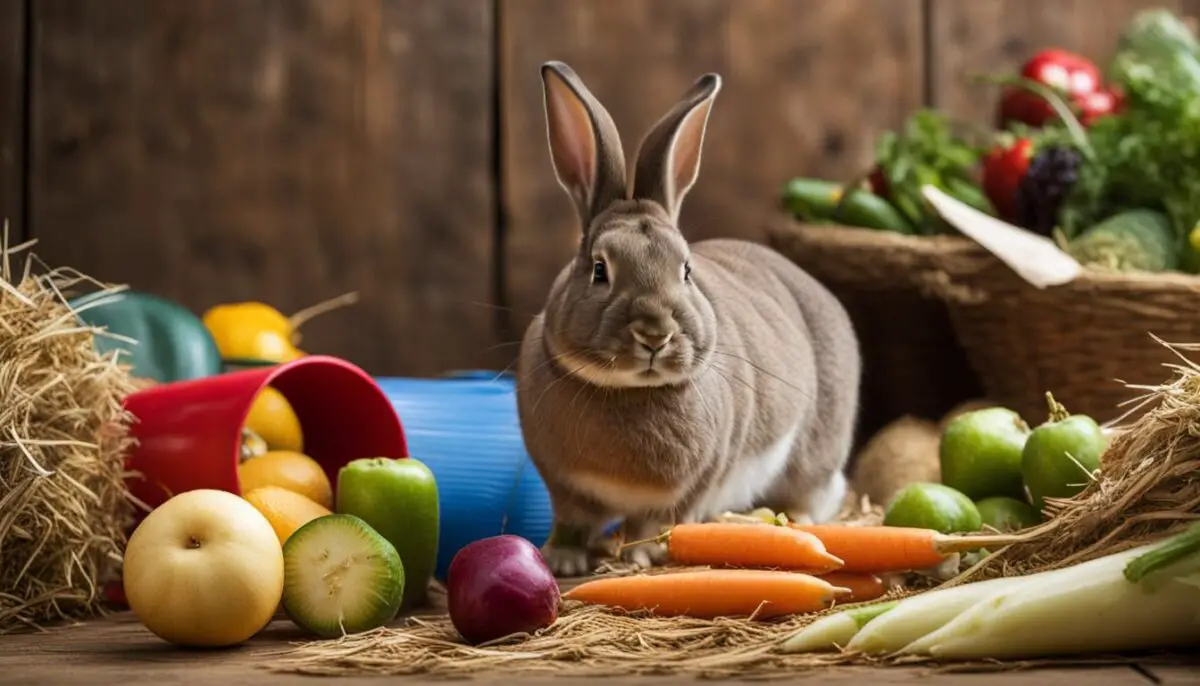Welcome to our fascinating exploration of rabbit behavior! In this article, we will delve into the intriguing world of rabbit thumping and uncover the reasons behind this unique behavior. Have you ever wondered why rabbits thump their hind feet? Or who they are trying to communicate with through this rhythmic action? Join us as we unravel the mysteries of rabbit thumping behavior.
Key Takeaways:
- Rabbit thumping is a form of communication that involves a rabbit rapidly drumming or stomping its hind feet.
- Thumping can serve as a warning of danger or a means to express annoyance.
- The frequency of thumping varies among rabbits and can be influenced by their personality and environment.
- Understanding rabbit body language and specific triggers is crucial for interpreting their thumping behavior.
- Creating a safe and enriching environment is essential for the overall well-being of rabbits.
Who Do Rabbits Thump
Anatomy of Rabbit Thumping
Rabbit thumping is a unique behavior that is characterized by a rabbit rapidly drumming or stomping both hind feet. This action produces a distinct thumping noise that can be heard by both humans and other rabbits. Thumping is not a random or arbitrary behavior; it is a deliberate form of communication used by rabbits to express their emotions and needs.who do rabbits thump
When a rabbit thumps, it typically occurs in a series of one or multiple thumps. The rabbit may pause briefly between thumps or continue without pause, depending on the intensity of their emotions or the perceived level of threat. Following a thumping episode, a rabbit may freeze in place or seek shelter, which further indicates their perception of danger or annoyance.why do rabbits thump
Rabbit thumping is a visual and auditory display of communication. It serves as a signal to other rabbits in the vicinity to be alert and on guard, as it may indicate the presence of danger or something that is causing the rabbit to feel anxious or threatened. Understanding the meaning behind rabbit thumping is crucial for rabbit owners and enthusiasts to provide appropriate care and support for their furry companions.
Table: Rabbit Thumping Behavior
| Thumping Behavior | Meaning |
|---|---|
| Rapid drumming or stomping of hind feet | Expression of danger or annoyance |
| Accompanied by one or multiple thumps | Varies depending on intensity of emotions |
| Rabbit may freeze or seek shelter after thumping | Indication of perceived threat or need for safety |
By observing a rabbit’s body language and the context in which thumping occurs, it is possible to gain insights into their emotional state and respond accordingly. Rabbit thumping is just one aspect of their complex communication system, and understanding it can help strengthen the bond between rabbits and their human caretakers.rabbit thumping meaning
Thumping for Danger
Thumping is often used by rabbits as an alert to danger. When a rabbit senses a potential threat, such as a loud noise or unfamiliar presence, they may thump to warn others. Understanding the context of the thumping, such as the rabbit’s surroundings and behavior before the thumping, can help interpret the specific danger or trigger. rabbit thumping communication
Rabbits have a keen sense of hearing and are highly vigilant animals. They rely on thumping as a way to communicate potential danger to their warren (a group of rabbits) or to other rabbits nearby. This behavior can be especially common in outdoor rabbits or those kept in open environments where they are more exposed to external stimuli.reasons for rabbit thumping
Interpreting rabbit thumping requires careful observation and an understanding of their natural instincts. For example, if a rabbit is thumping while outdoors, it may be signaling the presence of a predator, such as a fox or a hawk. On the other hand, if a rabbit thumps indoors, it could be reacting to a sudden loud noise or the presence of a new, unfamiliar object.rabbit thumping as a warning sign
Interpreting Rabbit Thumping
To accurately interpret rabbit thumping, it is important to observe the rabbit’s body language and other behavioral cues. For instance, if a rabbit is thumping while crouched low to the ground and with ears pinned back, it indicates a high level of fear or stress. In contrast, if the rabbit is thumping while standing upright and alert, it may be a sign of heightened awareness and caution.rabbit body language thumping
It’s worth noting that not all thumping is necessarily a sign of immediate danger. Rabbits can also thump to express territoriality or frustration. For instance, if a rabbit is thumping repeatedly in response to another rabbit encroaching on its space, it may be asserting dominance or defending its territory.
In summary, rabbit thumping is a vital form of communication that allows rabbits to warn others of potential danger. By understanding the context and interpreting the rabbit’s body language, we can better respond to their needs and create a safe environment for them.
Thumping in Annoyance
Rabbits have their own unique ways of expressing their emotions, and one of them is through thumping. While thumping is commonly associated with danger, rabbits also use this behavior to communicate their annoyance or displeasure. Understanding thumping as a warning sign can help rabbit owners better meet their pets’ needs and create a harmonious environment for them.
When a rabbit feels annoyed or irritated, it may resort to thumping as a way to vent its frustration. This behavior can be triggered by various factors, such as loud noises, sudden movements, or unwanted handling. By observing a rabbit’s body language and the context in which thumping occurs, owners can identify the specific triggers and take steps to alleviate the rabbit’s annoyance.
It is important to remember that each rabbit is unique and may have different sensitivities. Some rabbits may be more prone to thumping in response to certain situations, while others may be more tolerant. Building a strong bond with your rabbit, providing them with a safe and comfortable living environment, and respecting their boundaries can go a long way in minimizing thumping episodes caused by annoyance.
Managing Rabbit Thumping:
- Avoid loud noises or sudden movements that may startle the rabbit.
- Approach the rabbit calmly and gently, ensuring they feel safe and secure during interactions.
- Provide hiding places and safe zones where the rabbit can retreat when they feel overwhelmed or irritated.
- Observe the rabbit’s behavior and body language to identify their triggers and avoid them when possible.
Remember, thumping in annoyance is a form of communication for rabbits. By understanding and respecting their needs, you can help create a peaceful and stress-free environment for your rabbit to thrive in.
Rabbit Thumping on the Internet
Rabbit thumping behavior has gained significant attention and discussion on the internet among rabbit owners and enthusiasts. Many individuals have shared their fascinating stories and experiences of rabbits thumping in various situations.
“My rabbit, Daisy, always thumps when she smells peanut butter,” shared one user on a popular rabbit forum. It seems that certain smells, like peanut butter, can trigger a thumping response in rabbits, highlighting the unique sensitivities of these furry creatures.
“I was amazed when my rabbit, Oliver, scared off a potential burglar by incessantly thumping during the night. He definitely knows how to protect his territory!”
This anecdote shows how rabbits can utilize their thumping behavior as a means of self-defense or protection, even in unexpected situations.
| Rabbit Thumping Stories |
|---|
| “My rabbit thumps whenever he sees a bird outside the window.” |
| “Our rabbit, Nibbles, thumps when we rearrange the furniture.” |
| “I’ve noticed my rabbit, Bella, thumping in response to thunderstorms.” |
These stories showcase the diverse range of triggers for rabbit thumping behavior and emphasize the importance of understanding and interpreting these signals to better care for and communicate with our furry friends.

Understanding Rabbit Behavior Online
The internet has provided a platform for rabbit owners to connect, share experiences, and seek advice when it comes to understanding rabbit behavior. From heartwarming stories to helpful tips, online communities have become an invaluable resource for rabbit enthusiasts.
- Share interesting rabbit thumping stories and anecdotes.
- Discuss different triggers for rabbit thumping behavior.
- Provide advice and support for rabbit owners dealing with thumping-related issues.
Through these online interactions, rabbit owners can gain insights into the complexity of rabbit behavior and learn from each other’s experiences. It is important to remember that every rabbit is unique, and what triggers thumping in one rabbit may not necessarily apply to another. The internet serves as a platform for knowledge-sharing and collaboration, allowing rabbit owners to provide the best care and understanding for their furry companions.
Rabbit Thumping and Personalities
Understanding rabbit thumping behavior involves recognizing that each rabbit has its own unique personality. Just like humans, rabbits have different triggers and thresholds that can influence how often and why they engage in thumping. Some rabbits may be more prone to thumping and may be easily triggered by certain stimuli, while others may thump less frequently.
Rabbit thumping triggers can vary widely from one individual to another. It can be helpful for rabbit owners to observe their rabbits closely to identify what specific triggers may cause them to thump. Common triggers include loud noises, sudden movements, unfamiliar scents, and changes in their environment. By recognizing and understanding these triggers, rabbit owners can provide appropriate care and minimize stress for their furry companions.
While some rabbits may thump more frequently, it is important to note that an absence of thumping does not necessarily indicate a lack of a rabbit’s personality or emotions. Some rabbits may simply have different ways of expressing themselves or may not be as sensitive to certain triggers. By taking the time to understand and adapt to each rabbit’s unique personality, we can create a positive and enriching environment for them.
Table: Rabbit Thumping Frequency by Personality Types
| Personality Type | Thumping Frequency |
|---|---|
| Highly Sensitive | Thumps frequently and easily triggered |
| Moderately Sensitive | Thumps occasionally, more selective triggers |
| Less Sensitive | Rarely thumps, requires strong triggers |
As shown in the table above, different personality types can exhibit varying levels of thumping frequency. It is essential for rabbit owners to provide individualized care and adjust their approach based on their rabbit’s personality and unique needs. By doing so, we can ensure that our rabbits feel safe, secure, and loved.
Helping Rabbits Feel Safe
If a rabbit thumps frequently or shows signs of fear or discomfort, steps can be taken to help them feel safe and secure. Identifying and minimizing the triggers that cause thumping is essential. For triggers that cannot be controlled, such as loud noises, desensitization techniques can be employed to help rabbits become more comfortable with the stimuli over time.
Desensitization involves gradually exposing the rabbit to the trigger in a controlled and safe environment. Start by introducing the trigger at a low intensity and gradually increase the exposure over time. For example, if a rabbit is afraid of loud noises, start by playing soft sounds and gradually increase the volume as the rabbit becomes more comfortable.
It is important to provide a safe and secure environment for rabbits to retreat to when they feel threatened. This can include providing hiding spots, such as tunnels or boxes, where rabbits can feel protected. Ensuring that their living space is free from potential dangers, such as sharp objects or toxic plants, is also crucial in preventing unnecessary stress.
Additionally, providing positive reinforcement and rewards can help rabbits associate trigger situations with positive experiences. For example, if a rabbit is afraid of a specific person, that person can offer treats or favorite toys to help the rabbit feel more at ease in their presence. Building trust and a positive association with trigger situations can go a long way in helping rabbits feel safe and reducing thumping behavior.

Additional Tips for Helping Rabbits Feel Safe:
- Establish a routine and predictable environment for rabbits, as they thrive on consistency.
- Provide plenty of mental and physical stimulation through toys, interactive playtime, and exploration opportunities.
- Monitor and manage the rabbit’s diet to ensure they are receiving proper nutrition and maintaining a healthy weight.
- Consider consulting with a rabbit-savvy veterinarian or animal behaviorist for professional guidance on managing rabbit behavior and reducing stress.
“Helping rabbits feel safe is crucial in maintaining their overall well-being and minimizing thumping behavior. By identifying triggers, using desensitization techniques, and providing a secure environment, we can create a positive and stress-free environment for rabbits to thrive.”
Understanding Rabbit Body Language
Rabbits have a unique language of their own, and understanding their body language can provide valuable insights into their emotions and needs. Decoding rabbit body language involves observing various cues such as ear position, posture, and vocalizations. By interpreting these behaviors, rabbit owners can better understand and communicate with their furry companions.

Ear Position
Rabbit ears are incredibly expressive and can provide important clues about their mood. When a rabbit’s ears are erect and facing forward, it indicates that they are alert and curious. If the ears are flattened against their back, it may mean they are feeling threatened or scared. Paying attention to the position of a rabbit’s ears can help gauge their emotional state and adjust interactions accordingly.
Posture
Rabbits use their body posture to convey a range of messages. If a rabbit is standing tall with their body relaxed, it signals that they are feeling calm and content. On the other hand, if a rabbit crouches down with their body tense and ready to flee, it suggests that they are frightened or anxious. Recognizing these postures can help caregivers create a safe and secure environment for their rabbits.
Vocalizations
Rabbits have a variety of vocalizations that they use to communicate with humans and other rabbits. Common vocalizations include purring, honking, growling, and loud thumping. Each vocalization carries a different meaning, and it’s essential to understand the context in which they occur. For example, a rabbit may purr when they are content, but they may also growl or thump to express annoyance or a sense of danger. It is important to listen and observe these vocalizations to better understand a rabbit’s emotional state.
Table: Rabbit Body Language Cues
| Behavior | Meaning |
|---|---|
| Erect ears facing forward | Curiosity and alertness |
| Flattened ears against the back | Threatened or scared |
| Relaxed, upright posture | Calm and content |
| Crouched, tense posture | Frightened or anxious |
| Vocalizations (purring, honking, growling, thumping) | Communication of various emotions and needs |
Signs of Discomfort in Rabbits
It is important for rabbit owners to be attuned to signs of discomfort or abnormal behavior in their beloved pets. These signs can indicate underlying fear or stress that may be causing the rabbits to exhibit unwanted behaviors, including thumping. By recognizing these signs early on, rabbit owners can take appropriate measures to address their rabbits’ needs and ensure their well-being.
Rabbits experiencing fear or discomfort may exhibit tense muscles and aggressive postures. They may also engage in excessive chewing on objects or emit unusual vocalizations. These behaviors are often indicators that the rabbit is feeling threatened or uneasy in its environment.
“Rabbits experiencing fear or discomfort may exhibit tense muscles and aggressive postures. They may also engage in excessive chewing on objects or emit unusual vocalizations.”
Additionally, rabbits may display signs of fear such as widened eyes, flattened ears, and a tucked tail. These physical cues can further indicate the rabbit’s discomfort and are important for owners to note.
Table: Common Signs of Fear in Rabbits
| Signs of Fear | Description |
|---|---|
| Tense muscles | Rabbit’s body feels stiff and rigid |
| Aggressive postures | Rabbit lunges, growls, or bites |
| Excessive chewing | Rabbit chews on objects excessively |
| Unusual vocalizations | Rabbit makes high-pitched or distressed sounds |
| Widened eyes | Rabbit’s eyes appear larger than usual |
| Flattened ears | Rabbit’s ears are pressed tightly against its head |
| Tucked tail | Rabbit tucks its tail close to its body |
By familiarizing themselves with these signs, rabbit owners can take appropriate action to alleviate their pets’ discomfort. Creating a calm and safe environment, providing hiding spaces, and avoiding known triggers can help rabbits feel more secure. Seeking guidance from a veterinarian or a rabbit behavior specialist can also be beneficial in addressing any underlying issues and improving the well-being of the rabbits.
Supporting Rabbit Welfare
Providing proper care and enrichment for rabbits is essential for their overall welfare and happiness. Here are some tips and considerations to ensure your rabbits have a safe and enriching environment:
1. Housing and Environment
Rabbits need a comfortable and spacious living space that allows them to exhibit natural behaviors. Provide them with a large enclosure or a bunny-proofed room where they can hop, run, and explore. Make sure the space is safe and free from hazards such as toxic plants, electrical cords, or small objects that could be ingested.
Additionally, rabbits thrive when they have hiding spots and different levels to climb. Offer them a variety of tunnels, boxes, and platforms to create a stimulating and engaging environment.
2. Enrichment and Toys
Enrichment activities are essential to keep rabbits mentally stimulated and prevent boredom. Provide them with a variety of toys such as chew toys, puzzle feeders, and cardboard boxes to encourage exploration and play. Rotate their toys regularly to keep them engaged.
It’s also important to offer rabbits opportunities for foraging and digging, as these are natural behaviors. Hide treats or fresh vegetables around their enclosure for them to search for, or create a dig box filled with safe materials like shredded paper or straw.
3. Social Interaction
Rabbits are social animals and benefit from interaction with their human caregivers and other compatible rabbits. Spend time with your rabbits daily, offering them gentle petting, grooming, or supervised playtime outside of their enclosure.
If you have more than one rabbit, make sure they are properly bonded and have enough space to coexist harmoniously. Provide separate hiding spots and resources to avoid competition or aggression.
4. Veterinary Care
Regular veterinary check-ups are important to ensure your rabbits’ health and well-being. Schedule routine visits with a rabbit-savvy veterinarian who can provide vaccinations, dental care, and overall health assessments.
Additionally, spaying or neutering your rabbits is highly recommended as it can prevent health issues and unwanted behaviors.
By implementing these practices, you can support the welfare of your rabbits and provide them with a fulfilling and happy life.

Conclusion
In conclusion, understanding rabbit behavior and communication methods is essential for providing appropriate care and ensuring the well-being of these furry companions. Thumping is a unique way in which rabbits express danger and annoyance, signaling their emotions to others. By interpreting their body language and recognizing specific triggers, we can better respond to their needs and create a safe and supportive environment.
Rabbits have a complex language of their own, including various behaviors, postures, and vocalizations. Thumping is just one aspect of their communication, and it is important to take into account other cues such as ear position and overall body posture. This holistic approach allows us to decode their emotions and address any potential sources of stress or discomfort.
To support rabbit welfare, it is crucial to provide a safe and enriching environment. This involves offering hiding spaces, toys, and opportunities for physical and mental stimulation. Regular veterinary check-ups are also important for monitoring the health and well-being of rabbits. By prioritizing their needs and understanding their unique personalities, we can ensure that rabbits lead happy and fulfilling lives.
FAQ
Who do rabbits thump?
Rabbits of all ages and breeds can thump, but not all rabbits do. Thumping behavior can vary depending on the rabbit’s personality and environment.
Why do rabbits thump?
Rabbits thump as a form of communication. It can be a way for them to express danger or annoyance to others.
What is the meaning of rabbit thumping?
Rabbit thumping is a way for rabbits to warn others of potential danger or to communicate their unhappiness with a certain situation.
How can I interpret rabbit thumping?
Understanding the context of the thumping, such as the rabbit’s behavior before and after, can help interpret the specific danger or trigger.
Is rabbit thumping a warning sign?
Yes, rabbit thumping can be a warning sign. It is a way for rabbits to communicate their displeasure or dissatisfaction with a certain situation or interaction.
Are there any interesting rabbit thumping stories?
Yes, rabbit owners have shared anecdotes of rabbits thumping in response to specific triggers, such as the smell of peanut butter or the rearrangement of furniture. There are even cases where rabbits have thumped to scare off potential burglars.
Do all rabbits thump the same way?
Each rabbit has its own unique personality, which can influence their thumping behavior. Some rabbits may be more prone to thumping, while others may thump less frequently.
How can I help a rabbit feel safe if they thump frequently?
Steps can be taken to help rabbits feel safe, such as identifying and minimizing the triggers that cause thumping. Desensitization techniques can also be employed to help rabbits become more comfortable with certain stimuli over time.
What other forms of communication do rabbits have?
Rabbits have a complex language of their own, which includes factors such as ear position, posture, and vocalizations. These all contribute to their overall communication.
What are signs of discomfort in rabbits?
Signs of discomfort in rabbits can include tense muscles, aggressive postures, excessive chewing on objects, and unusual vocalizations.
How can I support rabbit welfare?
Supporting rabbit welfare involves creating a safe and enriching environment, providing hiding spaces, toys, and opportunities for physical and mental stimulation. Regular veterinary check-ups are also important for monitoring their health and well-being.


